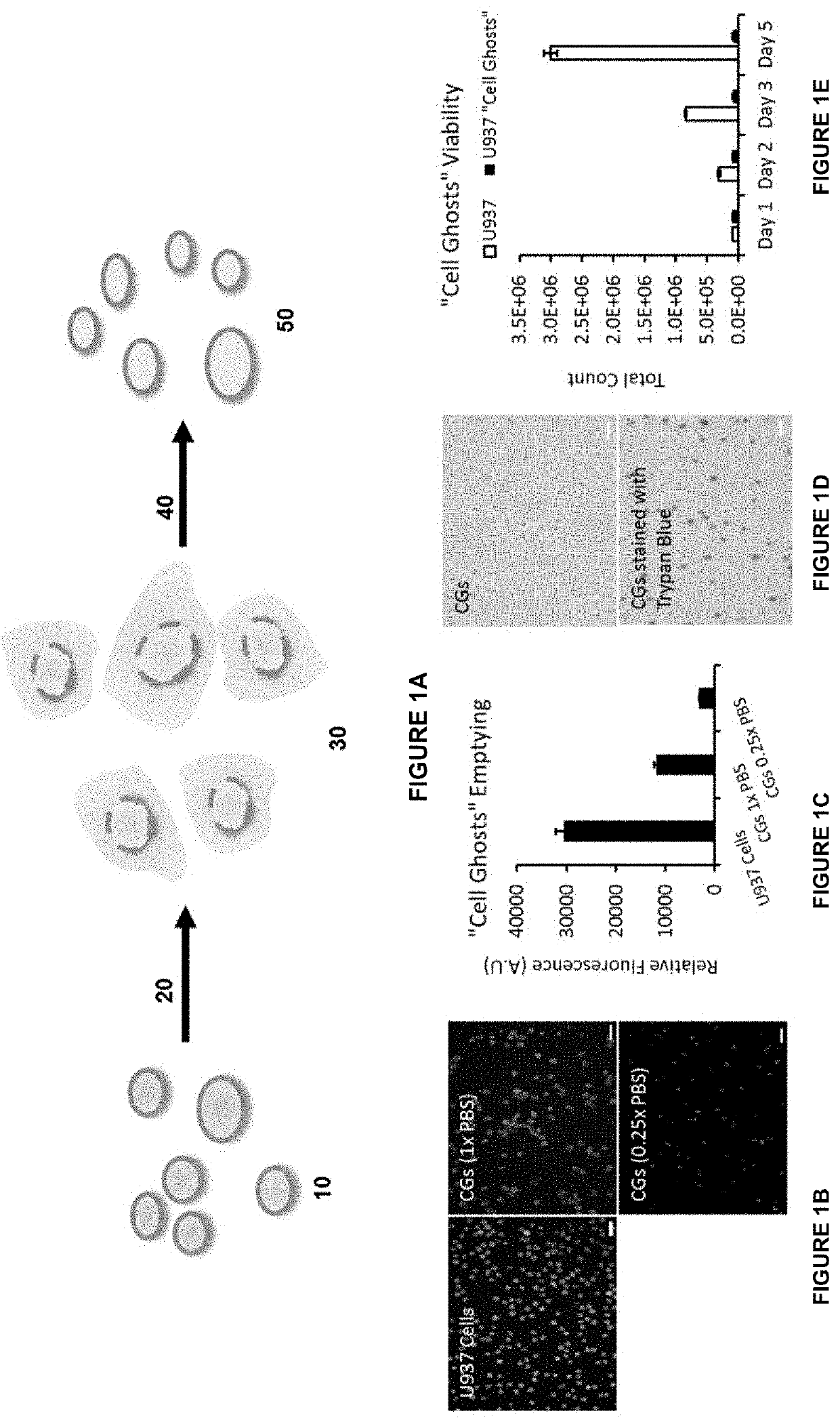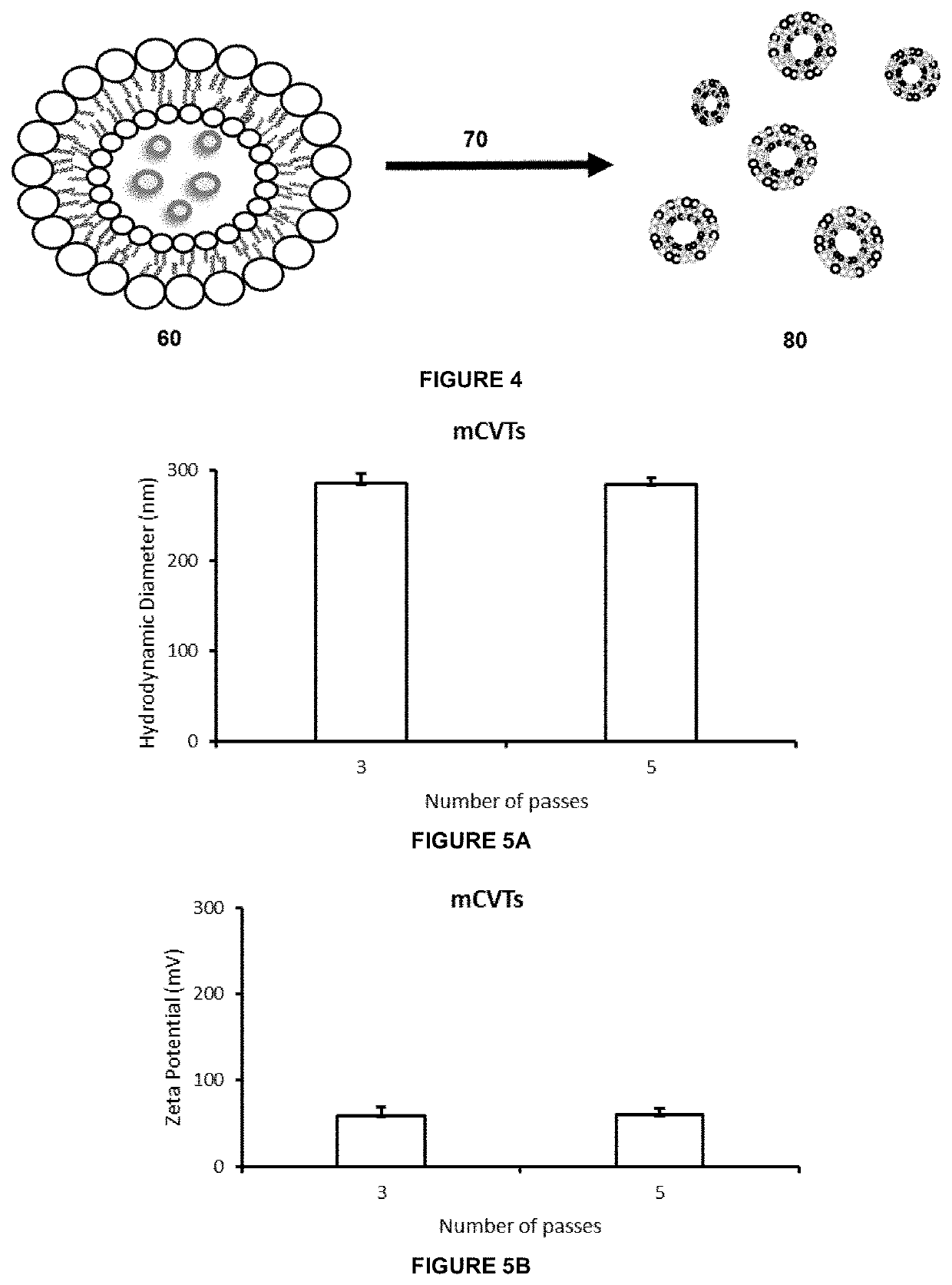Biomolecular composites comprising modified cell ghosts
a technology of modified cells and composites, applied in the field of biomolecular composites, can solve the problems of not being satisfactory, the cellular uptake of nanoparticles in the liposomal system is relatively low, and the transfection into hard-to-transfect (htt) cells is not satisfactory
- Summary
- Abstract
- Description
- Claims
- Application Information
AI Technical Summary
Benefits of technology
Problems solved by technology
Method used
Image
Examples
example 1
[0251]Cell Ghost Production
[0252]A schematic illustration of the cell ghost production is shown in FIG. 1A. U937 cells 10, human monocytes, were used as a model for cell ghost production. The U397 cells 10 were subjected to overnight shaking in 0.06% w / v sucrose sequentially in 0.25×, 0.1× and 0.25×PBS in step 20 to form U937 cells with “leaky” membranes 30. Next, in step 40 the U937 cells with “leaky” membranes 30 were shaken overnight in 0.06% w / v sucrose in 1×PBS to form resealed U937 cell ghosts 50. The cell ghost production is described in detail below.
[0253]Between 1×107 and 2×107 U937 monocytes were immersed in 2 ml of 0.06% w / v sucrose solution diluted with 0.25×PBS at room temperature in a 12 well plate on a tabletop shaker. Protease inhibitor cocktails, purchased commercially, were added in a ratio of 10 μl to 2 ml of the cell suspension. The cells are kept on a shaker for 24 hours.
[0254]Subsequently, the cells were centrifuged at 6000 G for 10 minutes at 4° C. to pellet t...
example 2
[0259]Cell Ghost Emptying
[0260]The cell emptying process was elucidated by incorporating the CellTracker™ Green CMFDA dye within the cells before cell ghost production. The dye is converted to a membrane impermeable form once it passes through cell membranes, and is used as an indicator to demonstrate the emptying of the cellular contents in the cell ghost's production process.
[0261]1×107 U937 cells were stained with CellTracker™ Green CMFDA dye as per manufacturer's recommendations. The stained cells were used in the preparation of cell ghosts. U937 cells were cultured till 70% confluency and the cells were centrifuged at 500 G×10 minutes, washed once with Phosphate Buffered Saline (PBS) and suspended in 0.06% w / v sucrose in 0.25×PBS on a shaker overnight at room temperature. The suspension was supplemented with 1% v / v penicillin streptomycin antibiotics and 0.5% v / v Protease Inhibitor cocktail. The cell suspension was subsequently centrifuged at 6000 G×10 minutes and suspended in ...
example 3
[0266]Preparation of mCVTs (Freeze Thaw Cycles)
[0267]A schematic illustration of mCVT production is shown in FIG. 4. Biomolecular composites were produced by addition of 1×107 cell ghosts to 10 mg of 1,2-dioleoyl-3-trimethylammonium-propane (DOTAP) lipids to form cell ghosts encapsulated in giant multilamellar liposomes 60. The DOTAP was first weighed, dissolved in 1 ml of chloroform and subsequently dried to create a thin film in an Eppendorf tube under vacuum using a rotatory evaporator. 1×107 cell ghosts were added to the thin film and sonicated in a bath for 1 hour and the mixture was freeze thawed by cycling between liquid nitrogen and room temperature respectively for up to 5 cycles in process 70. The resultant fused biomolecules 80 are characterised as mCVTs and their physical characteristics are shown in FIG. 3 and schematically in FIG. 4. As a result of fusion between the DOTAP film and cell ghosts, mCVTs become progressively larger with each freeze thaw cycle. For example,...
PUM
| Property | Measurement | Unit |
|---|---|---|
| hydrodynamic diameter | aaaaa | aaaaa |
| hydrodynamic diameter | aaaaa | aaaaa |
| hydrodynamic diameter | aaaaa | aaaaa |
Abstract
Description
Claims
Application Information
 Login to View More
Login to View More - R&D
- Intellectual Property
- Life Sciences
- Materials
- Tech Scout
- Unparalleled Data Quality
- Higher Quality Content
- 60% Fewer Hallucinations
Browse by: Latest US Patents, China's latest patents, Technical Efficacy Thesaurus, Application Domain, Technology Topic, Popular Technical Reports.
© 2025 PatSnap. All rights reserved.Legal|Privacy policy|Modern Slavery Act Transparency Statement|Sitemap|About US| Contact US: help@patsnap.com



